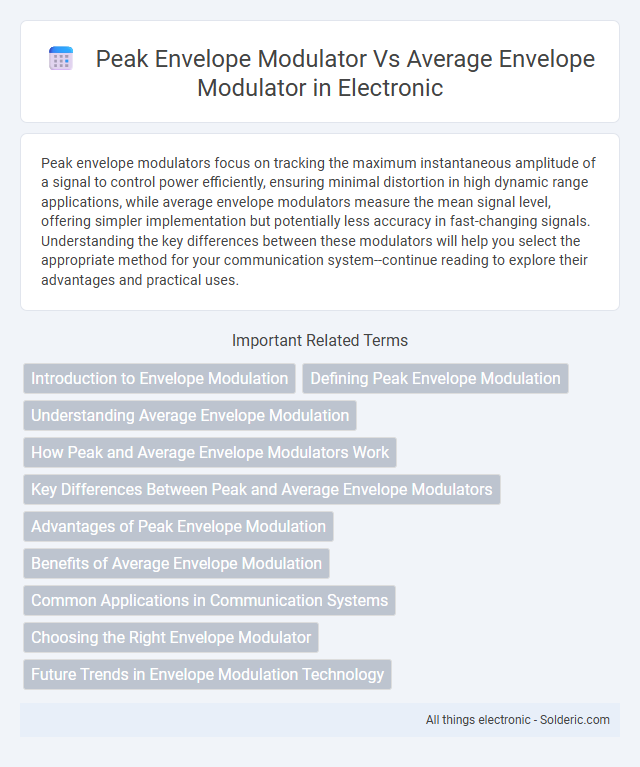Peak envelope modulators focus on tracking the maximum instantaneous amplitude of a signal to control power efficiently, ensuring minimal distortion in high dynamic range applications, while average envelope modulators measure the mean signal level, offering simpler implementation but potentially less accuracy in fast-changing signals. Understanding the key differences between these modulators will help you select the appropriate method for your communication system--continue reading to explore their advantages and practical uses.
Comparison Table
| Feature | Peak Envelope Modulator | Average Envelope Modulator |
|---|---|---|
| Definition | Modulates signal based on the peak value of the envelope. | Modulates signal based on the average value of the envelope over time. |
| Response Time | Fast response to signal peaks. | Slower response, smoothing out short-term variations. |
| Signal Accuracy | Captures transient peaks accurately. | May miss rapid peaks due to averaging. |
| Application | Used in applications requiring peak detection like limiters and compressors. | Ideal for noise reduction and smoother modulation. |
| Complexity | Often simpler with direct peak detection mechanisms. | More complex due to averaging algorithms. |
| Distortion | Less distortion in peak accuracy but can cause pumping effect. | Better for reducing distortion but less precise in extreme peak control. |
| Use Case Examples | Audio limiters, dynamic range compressors. | Noise gate smoothing, broadcast transmission. |
Introduction to Envelope Modulation
Envelope modulation controls the amplitude variations of a carrier signal to encode information in communication systems. Peak envelope modulators track the maximum amplitude of the input signal, ensuring rapid response to signal peaks, which benefits systems requiring precise dynamic range control. Average envelope modulators calculate the mean amplitude over time, providing smoother modulation ideal for reducing distortion in audio and analog signal processing.
Defining Peak Envelope Modulation
Peak Envelope Modulation (PEM) controls the maximum amplitude of a signal, ensuring that the instantaneous peak remains within desired limits for optimal power efficiency. Unlike Average Envelope Modulation, which regulates signal power based on average amplitude values, PEM provides precise control over peak signals to prevent distortion and improve system linearity. Your communication systems benefit from PEM by maintaining signal integrity during high-amplitude variations, crucial for accurate signal transmission.
Understanding Average Envelope Modulation
Average envelope modulation captures the mean power variations of a signal, providing a stable representation ideal for consistent audio compression and noise reduction. Unlike peak envelope modulators, which react to instantaneous signal peaks, average envelope modulators smooth rapid fluctuations, reducing distortion and improving listening comfort. Your audio system benefits from this approach by maintaining balanced signal dynamics and preventing abrupt amplitude changes.
How Peak and Average Envelope Modulators Work
Peak envelope modulators detect the maximum instantaneous amplitude of an input signal to modulate the carrier wave, ensuring the transmitted signal maintains fidelity during rapid amplitude changes. Average envelope modulators calculate the mean amplitude over a specific time window, smoothing out short-term fluctuations and providing a more stable modulation envelope. Peak modulators excel in preserving transient details, while average modulators offer reduced distortion in noisy or fluctuating signals.
Key Differences Between Peak and Average Envelope Modulators
Peak envelope modulators respond to the maximum instantaneous amplitude of the signal, ensuring rapid and precise modulation suitable for preserving signal integrity in high-peak environments. Average envelope modulators track the mean signal level, resulting in smoother modulation but potentially less responsiveness to sudden amplitude changes. Your choice between peak and average envelope modulation impacts system performance, especially in dynamic applications like RF transmitters and communication systems.
Advantages of Peak Envelope Modulation
Peak envelope modulation offers superior signal accuracy by precisely tracking the instantaneous amplitude of the carrier wave, reducing distortion and improving overall audio fidelity. It enhances the dynamic range of your transmitted signal, ensuring clearer and more reliable communication, especially in complex modulation schemes like AM or certain analog systems. This technique also minimizes interference with adjacent channels by maintaining strict amplitude limits, resulting in better spectral efficiency compared to average envelope modulation.
Benefits of Average Envelope Modulation
Average envelope modulation reduces power consumption by smoothing the driving signal, leading to improved efficiency in RF amplifiers. It minimizes distortion and spectral regrowth compared to peak envelope modulators, enhancing signal integrity and linearity. This approach enables better thermal management and longer device lifespan in communication systems.
Common Applications in Communication Systems
Peak envelope modulators are commonly used in high-power RF amplifiers for radar and satellite communication systems where precise control of signal peaks is critical to prevent distortion and power inefficiency. Average envelope modulators find applications in mobile and cellular communication infrastructures, optimizing power consumption and improving battery life by maintaining consistent signal strength over time. Your choice between these modulators depends on the specific requirements of signal integrity and power efficiency within the communication system.
Choosing the Right Envelope Modulator
Selecting the right envelope modulator depends on the application's sensitivity to signal dynamics and distortion. A peak envelope modulator is ideal for systems demanding high linearity and minimal signal distortion, as it tracks the instantaneous peak amplitude, preserving signal integrity in complex modulation schemes. In contrast, an average envelope modulator suits applications where smoother amplitude variations are acceptable, offering simpler implementation and reduced sensitivity to rapid amplitude fluctuations.
Future Trends in Envelope Modulation Technology
Future trends in envelope modulation technology emphasize enhanced efficiency and precision, with peak envelope modulators offering superior dynamic range and faster response times compared to average envelope modulators. Advanced algorithms and AI integration are driving improvements in peak envelope modulators, enabling better signal clarity and reduced distortion in modern communication systems. Your choice between these modulators will increasingly depend on specific application demands such as power efficiency and modulation accuracy.
Peak envelope modulator vs average envelope modulator Infographic

 solderic.com
solderic.com